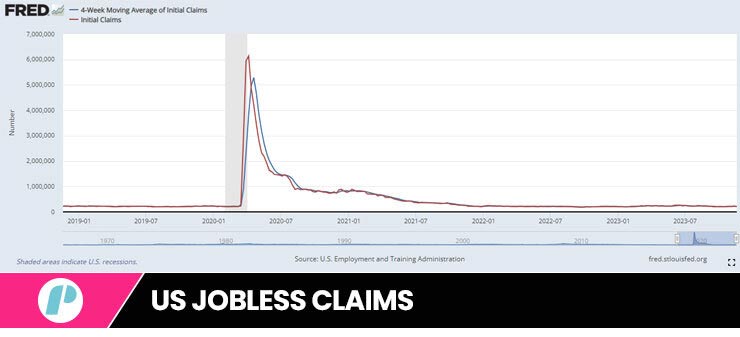
Introduction
In past articles, we have discussed some of the most important economic indicators that traders, investors, and other stakeholders are known to pay great attention to; the “Initial Jobless Claims” is undoubtedly one of them.
The report reveals the number of people who have recently become unemployed and are applying for unemployment benefits. By analyzing the records and figures the Initial Jobless Claims provides, market participants and policymakers can gain valuable insight into both the health of the labor market and the state of the overall economy.
In this article, we’ll explain what the Initial Jobless Claims report is and why it is considered so important.
What Are Initial Jobless Claims?
As we just explained above, Initial Jobless Claims refer to the number of people who filed a claim for unemployment benefits with their state’s unemployment office for the first time after losing their job. These claims are a key component of the weekly Economic Indicators Report which, in the US, is published by the Department of Labor.
Considering the fact that the employment levels are usually sensible to economic expansions and retractions, it becomes easy to see how the Initial Jobless Claims report is seen and used as a barometer not only for the state of the labor market but also for the overall national economic condition.
Analysts and policymakers rely on this data to make informed decisions regarding economic policies, social safety nets, and business strategies. By closely monitoring initial jobless claims, all interested parties can gain insights into the impacts of economic events, such as recessions and unexpected crises such as the recent global pandemics, and can devise appropriate measures to mitigate their effects.
Why the Initial Jobless Claims are so important for traders and investors?
The importance of the IJC to traders and investors derives from the fact that it can be viewed not only as an indicator of the current economic situation but also as an insight into what is likely to happen next.
Let’s take a minute to analyze this better.
The most direct and immediate use of the Initial Jobless Claims report is as an indicator of economic health.
High numbers of initial jobless claims are often associated with a weakening labor market and can indicate an economic downturn, a slowing down, or, in extreme cases, a recession. Whilst, on the other hand, a decline in claims can signal improving employment prospects and overall economic growth.
Initial jobless claims can act and it can be seen as an early warning system for related economic issues.
Clearly, an increase in jobless claims is seldom a good sign; it may foreshadow an imminent contraction in consumer spending followed by poorer market conditions and reduced economic growth.
The Initial Jobless Claims report is also considered of great importance for the impact that it can have on consumer confidence which, in turn, can have a major effect on the economy. After all, it is only natural that unemployment creates uncertainty and that can turn into financial stress for individuals and their families. This again can (and often does) lead to a decrease in consumer spending, which, of course, is a significant driving force for economic growth. It is because of this that, Initial Jobless Claims have a direct influence on consumer confidence, overall economic stability, and, ironically, on future unemployment level and jobless claims too.
What effect does the New Jobless Claims report have on the stock market?
When interpreting initial jobless claims, it is important to put the figures into context within the bigger picture. You must look beyond a single week’s data, as these can be influenced by various factors (i.e. seasonal fluctuations, reforms, weather conditions, etc.) or administrative problems. You should focus instead on indicators such as the four-week moving average (the average of initial claims over the previous four weeks) to get a better understanding of the overall status and dynamics of the labor market.
The relationship between the initial jobless claims and the stock market is often complicated because it is based on different factors with different timelines. The effect that one has on the other is not always easy to predict but there are, nonetheless, factors that it is useful to consider; here are a few.
The first thing that feels the impact of the Initial Jobless Claims report is market sentiment. Higher-than-expected jobless claims may lead to a decline in investor confidence, potentially causing stock prices to fall and, naturally, the opposite is true too.
As we just discussed, Initial Jobless Claims can provide insight into the health of the labor market and the overall economy. If jobless claims increase significantly, for example, it may be seen as revealing economic weakness or as a reason to prepare for “under-expectation” corporate earnings in the near future. Both these scenarios often lead to falling stock prices.

In past articles, we explained that the main functions of the Federal Banks are to safeguard the value of the US Dollar and the level of employment in the Country. It is only natural then that: high jobless claims may persuade the FED to adopt expansionary monetary policies, such as lowering interest rates or implementing asset purchase programs.
Usually, when the FED decides to act this way, traders can expect a positive response from the market, as a lower interest rate may make stocks more attractive than other assets.
It is important to also consider the impact New Jobless Sales can have on specific industries.
As discussed, changes in jobless claims numbers can directly influence market and consumer confidence; sectors heavily reliant on consumer spending, such as retail and travel, hospitality, and entertainment are more easily influenced and their stock prices may show greater volatility in response to jobless claims data.
For day traders in particular, it’s important to consider that the stock market’s reaction to jobless claims is very reliant on expectations and, in particular, to the way the newly released numbers compare to forecasts. If the actual jobless claims figure is better or worse than expected, it may affect market sentiment and stock prices in either a positive or negative way.
Note that…
It’s important to note that the stock market is influenced by a wide range of factors, including economic indicators, geopolitical events, company-specific news, and investor sentiment. Therefore, while initial jobless claims can be a factor, they are just one among many that constantly influence the stock market’s movement.
`Adding this knowledge to your technical analysis can give you a competitive edge and help you to improve your trading strategy.
Thanks for following us and, as always, I hope this helps.
If you liked this post make sure to share it!





